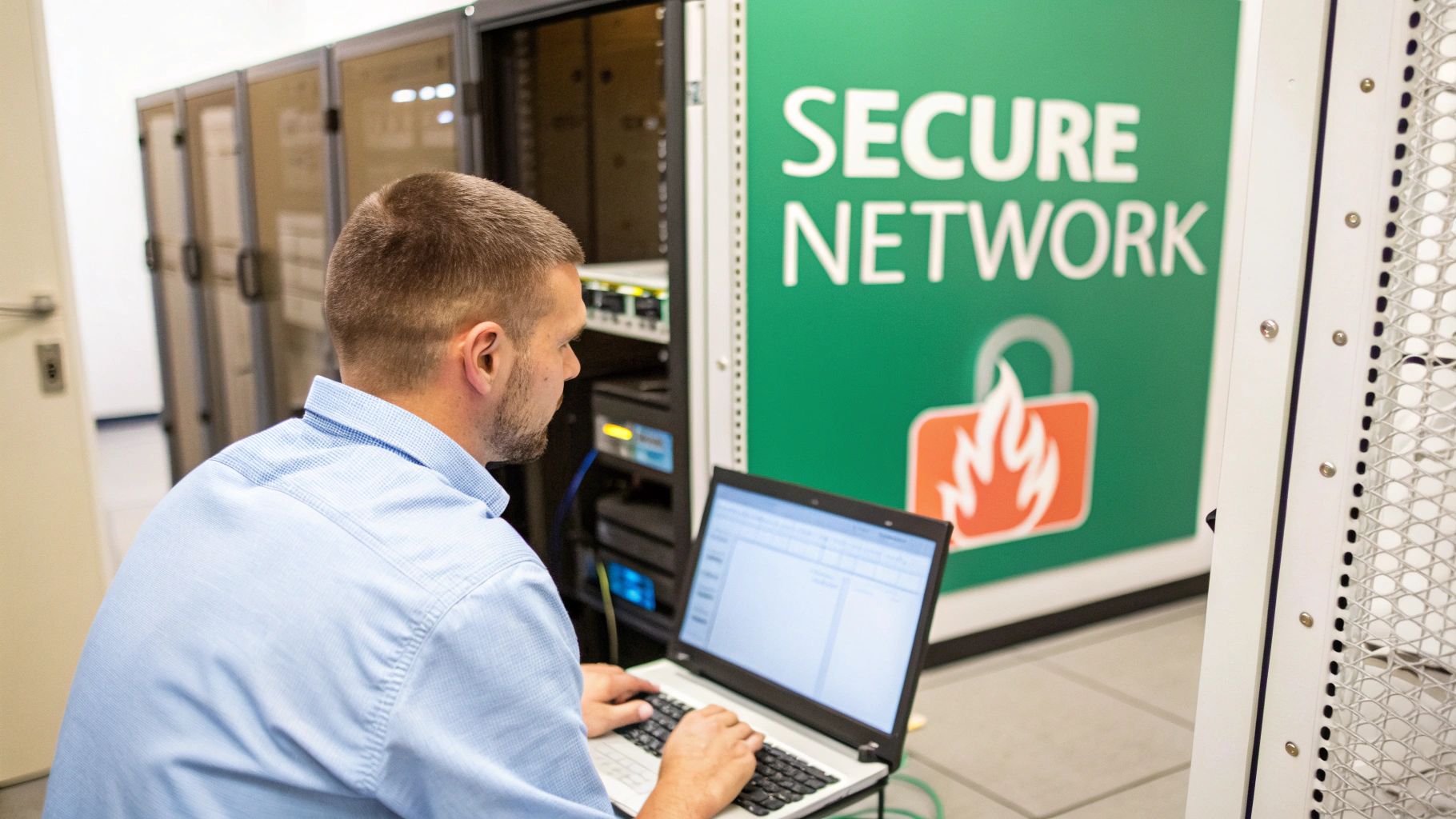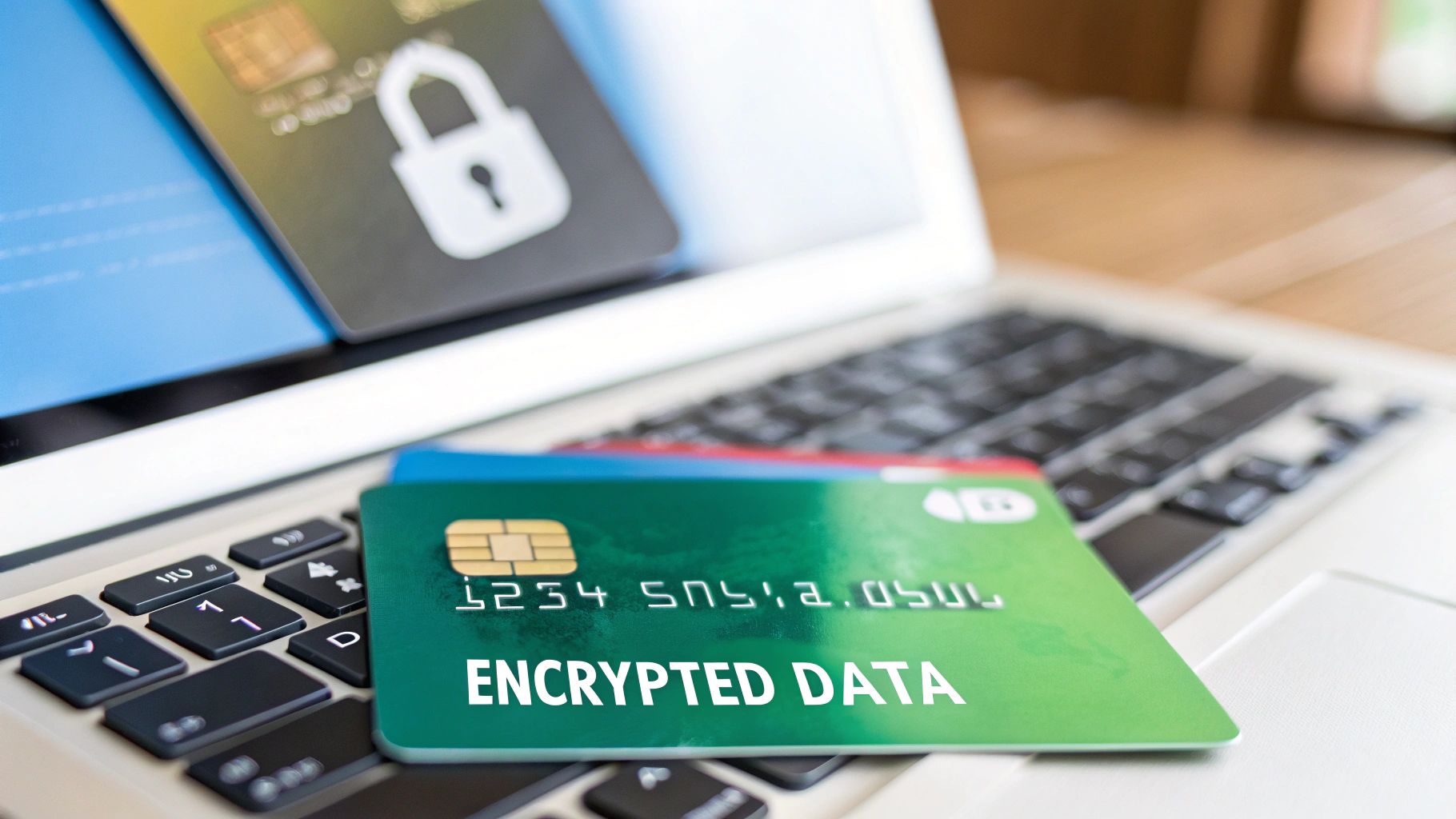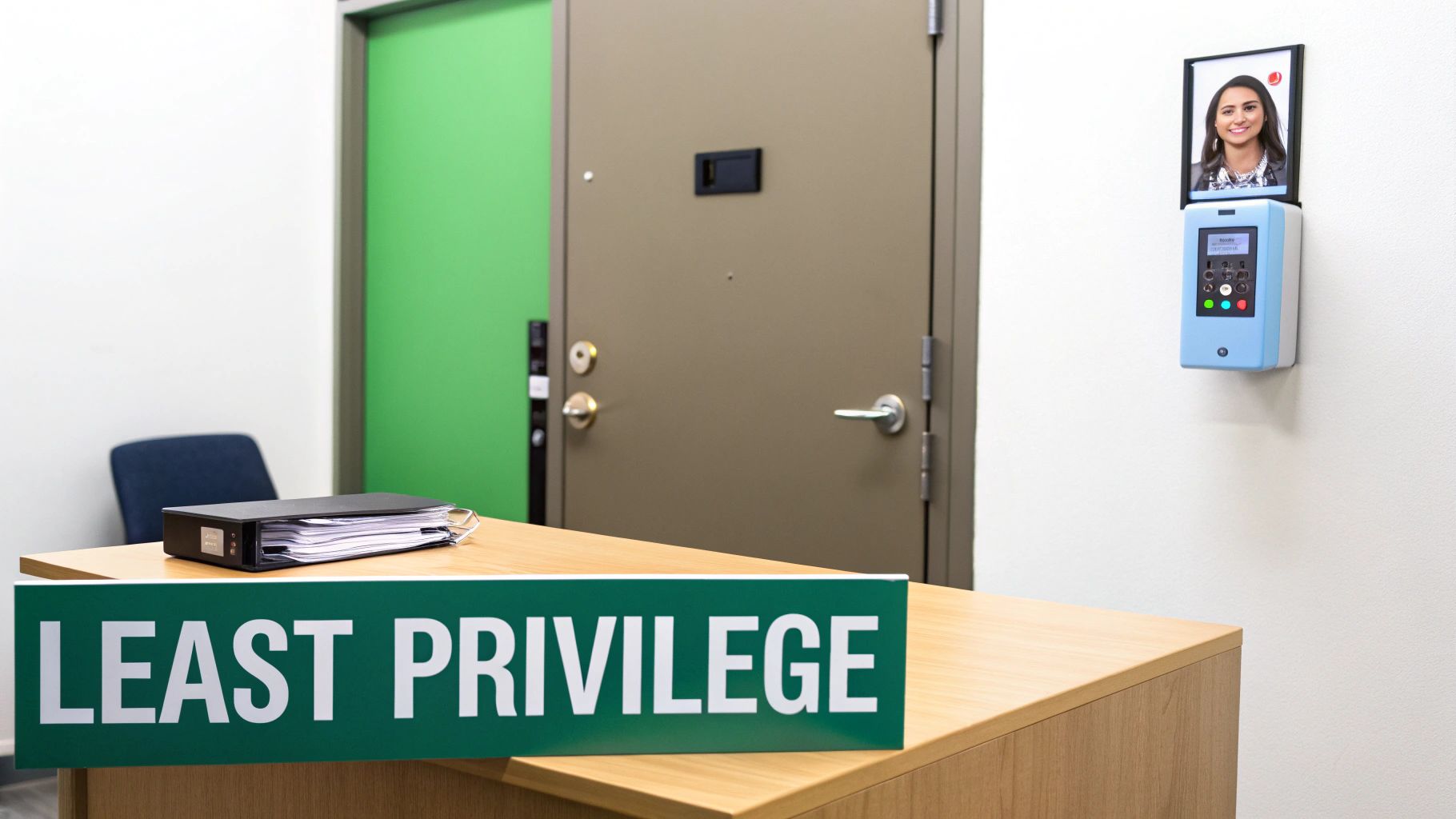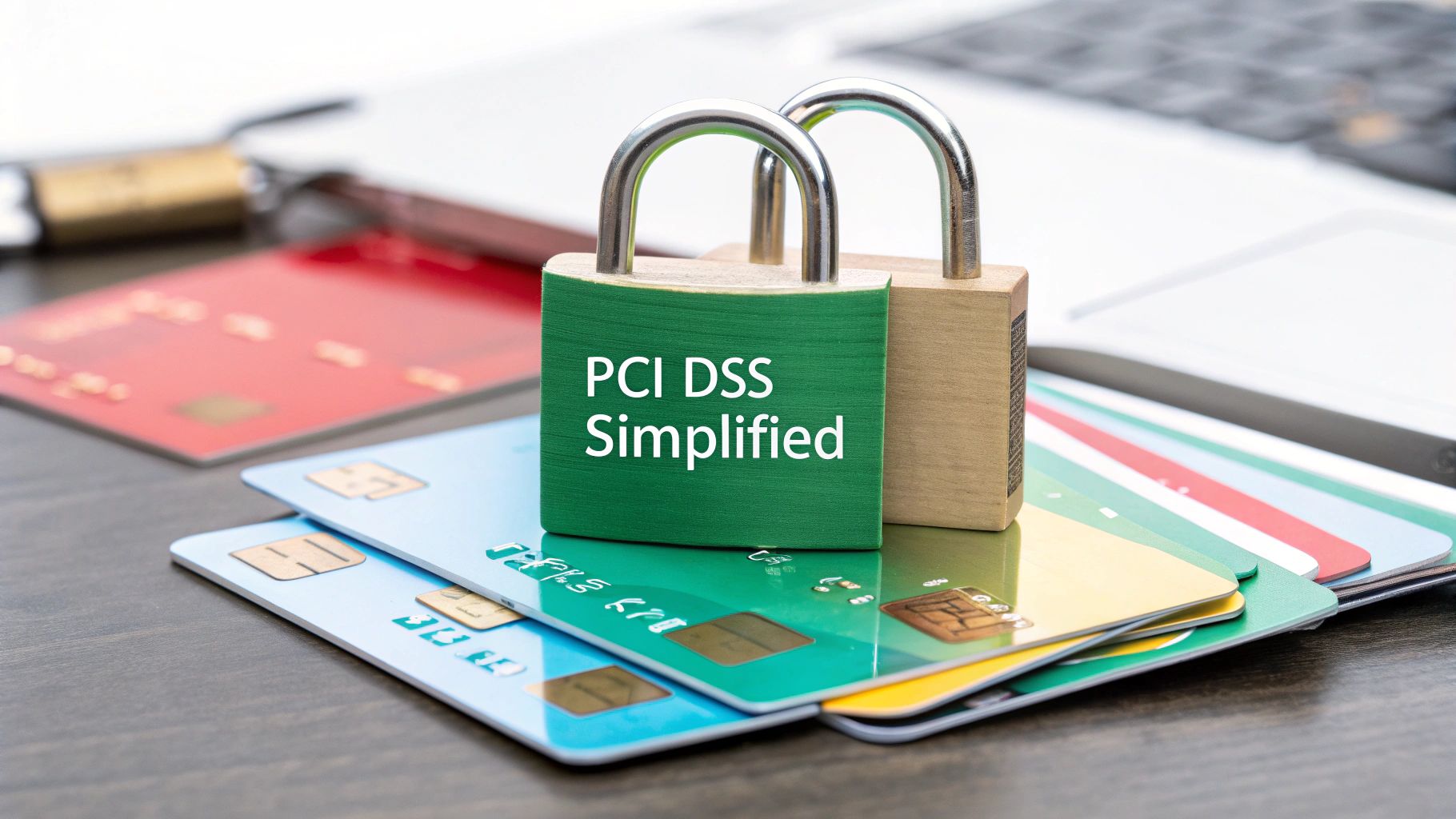Handling credit card data means you must follow the Payment Card Industry Data Security Standard (PCI DSS). These aren't suggestions; they are the rules for protecting payment information. Failing to comply can lead to huge fines, starting from $5,000 to $100,000 per month for serious breaches.
At Affordable Penetration Testing, we help you meet these requirements with fast, no-nonsense security testing. We deliver a full PCI DSS penetration test report in as little as a week, often for a flat $4,999 fee.
Understand the 12 PCI DSS Requirements
PCI DSS is built around protecting cardholder data. The standard has six main goals, broken down into 12 specific requirements. Together, they create a full security framework for handling every payment card transaction.
Getting these right is about keeping customer trust. This diagram shows how the six goals lead to the 12 requirements, creating layers of defense for your payment systems.
As you can see, each rule builds on the others. It’s a complete approach, not just a list of tasks.
The logic is simple: secure your network, protect the data, manage vulnerabilities, control access, monitor everything, and back it up with a solid policy.
Understanding these rules is your first step. If you need a more detailed breakdown, this practical guide to PCI compliance is a great resource. We also have a straightforward PCI DSS compliance checklist to translate each requirement into actionable steps.
Build a Secure Network to Protect Data
The first two PCI DSS requirements are the foundation of your security. Think of them as building a fortress and changing the locks. Get these wrong, and nothing else matters.
Requirement 1 is about setting up a strong perimeter with firewalls. A firewall is your digital gatekeeper, inspecting all traffic and blocking anything suspicious. It's not a "set it and forget it" device; it needs constant management.
Your firewall rules must be strict. The goal is to only allow traffic that is 100% necessary for business. Everything else gets blocked. This shrinks the attack surface for hackers.
Secure Your Systems From the Start
Requirement 2 tackles a common but huge mistake: using default passwords from vendors. When you get a new router or server, it often comes with a password like "admin." Leaving it is like taping the keys to your front door.
Attackers use automated tools to scan for devices with default credentials. Changing them is an easy and critical security win. But it's not just about passwords. You also have to disable any services you don't need.
Nailing these first two requirements sets a strong foundation. If you need help validating these controls, an affordable penetration test shows you exactly where your weaknesses are. We can deliver a full security audit report in as little as a week. Get in touch through our contact form to learn more.
Protect Cardholder Data at Rest and in Transit
Once your network is secure, you need to protect the actual data. PCI DSS Requirements 3 and 4 focus on making data useless to thieves, whether it's stored on your servers or moving across the internet.
Requirement 3 is about data at rest. The rule is simple: if you don't need it, don't store it. Hoarding credit card numbers is a huge liability.

For any card data you must keep, you have to make it unreadable. You can use encryption, truncation (showing only the last four digits), or tokenization. Most importantly, never store sensitive authentication data like the CVV code after a transaction.
Keep Data Safe When It Moves
Requirement 4 covers data in transit. Any time cardholder data travels over an open network like the internet, it must be encrypted. Sending unprotected payment data online is asking for it to be stolen.
This means using strong encryption like Transport Layer Security (TLS). You must use current versions and disable old, broken protocols like SSL. The new PCI DSS 4.0 standard emphasizes this.
If you need an expert to confirm your data is locked down, an affordable penetration test is the quickest way. Our OSCP and CREST-certified testers find weaknesses in your encryption and data storage, giving you a clear report in days. Contact us for fast and straightforward compliance testing.
Manage Vulnerabilities Proactively and Consistently
Security is not a one-time task. PCI DSS Requirements 5 and 6 are about having a proactive vulnerability management program. You need to actively find and fix weaknesses before attackers do.
Requirement 5 is your defense against malware. You must use antivirus software on all systems, keep it updated, and ensure it's always scanning for threats. It's the immune system for your network.

The PCI SSC's official library makes it clear these are mandatory controls.
Develop and Maintain Secure Applications
Requirement 6 focuses on the security of your software. This means building applications securely and patching them fast when new vulnerabilities are found. A slow patching process leaves the door wide open for a breach.
Your developers need training on secure coding to avoid common mistakes like SQL injection. All security patches from vendors must be installed quickly, usually within one month for critical issues. Following vulnerability management best practices is essential.
To know if your program is working, you have to test it. This is where vulnerability scans and penetration tests are vital. They prove your defenses can hold up against a real-world attack. We provide a comprehensive security audit for a flat $4,999 fee. Our OSCP and CREST-certified experts show you where you're vulnerable so you can fix it fast.
Check out our guide on vulnerability management best practices. If you're ready to prove your security, contact us for an ASAP pentest.
Implement Strong Access Control Measures
Once your systems are patched, you must control who can access them. Requirements 7, 8, and 9 are about making sure only the right people can get to sensitive information, both digitally and physically.
Requirement 7 is about the principle of least privilege. Every user should have the minimum level of access needed to do their job, and nothing more. A cashier doesn't need admin rights to your main server.
Requirement 8 is about accountability. Every person must have a unique user ID and a strong password. Shared accounts are a huge no-go because they destroy the audit trail. This is a core part of the pci dss compliance requirements.
Secure the Physical Environment Too
Requirement 9 deals with physical access. A great firewall doesn't help if someone can walk into your server room and steal a hard drive. This requirement is about locking the actual doors to your sensitive systems.
Use key cards or locks to control who enters server rooms. Keep a log of who comes and goes. Secure any physical media like paper receipts or backup tapes, and destroy them properly when they're no longer needed.
Not sure if your access controls are locked down? This is the perfect job for an affordable penetration test. Our ethical hackers test your digital and physical controls to find weaknesses before a real attacker does. We deliver a clear report in days, not weeks. Fill out our contact form to get started.
Regularly Monitor and Test Your Security
Building a fortress is pointless if no one is watching the walls. PCI DSS Requirements 10 and 11 are about actively watching and testing your defenses.
Requirement 10 is your digital surveillance system. You must track, log, and monitor everything that happens on your network, especially access to cardholder data. These logs are your record of who did what, and when.

Requirement 11 says you must prove your security controls work. You do this with regular vulnerability scans and penetration tests. A scan is an automated check for known flaws, while a penetration test is a manual, human-led simulated attack.
Make Security Testing Fast and Affordable
A pentest is crucial for PCI DSS because it uncovers complex flaws that automated tools miss. But traditional firms are slow and expensive, often taking months and costing tens of thousands.
We solve this problem. We offer affordable penetration testing services with fast turnarounds. We deliver a full report with clear, actionable steps in as little as one week. This isn't just for compliance; it's a real-world security assessment to make you safer.
See how it works in our deep dive into PCI DSS penetration testing. Monitoring and testing are core to the pci dss compliance requirements. If you need an urgent penetration test, fill out our contact form. We'll get you scheduled right away.
Maintain a Formal Information Security Policy
Requirement 12 ties all the other requirements together. It's about creating and maintaining a formal information security policy for your organization. This isn't just a document for an auditor; it's the rulebook for every security decision you make.
A strong policy sets clear expectations for everyone on how to handle cardholder data. It turns security from an idea into a set of responsibilities. Without a formal policy, your technical controls are missing the human element.
Your policy must address all 12 PCI DSS requirements. It should include defined roles, a security awareness training program, and an incident response plan. It is a living guide that must be reviewed at least once a year.
This requirement is about building a strong security culture. When everyone knows their role in protecting data, your company becomes more resilient. The policy turns your team into your strongest security asset.
If you need to validate that your policies and technical controls meet PCI DSS standards, Affordable Pentesting can help. Our fast, no-nonsense penetration tests give you a clear picture of your security in days, not months. Fill out our simple contact form for an affordable, flat-rate quote.
.svg)
